
Alzapúa is a technique consisting of thumbed upstrokes and downstrokes, generally in triplets or sixteenths, that form a melody on the bass strings with rhythmic counterpoint on the trebles. It seems very likely that it is a 20th-century development of an older technique involving the thumb and index finger. Both forms are present in the following examples of soleá and bulería from the art of Ramón Montoya, El Hijo de Salvador, Miguel Borrull, Niño Ricardo, Melchor de Marchena, Diego de El Gastor, Sabicas, Juan Carmona, Manuel Morao, Paco de Antequera, Manuel Parrilla and Paco de Lucía.
This mechanism seems to be the antecedent of alzapúa. It is this technique and not alzapúa that is heard in the recordings of Montoya, Melchor, Morao and others. There seems to be no widely accepted name for the mechanism; some refer to it as "horquilla," although this term is used to describe several very different techniques. Its origin seems to be thumbed eighth-note melodic lines (heard in the playing of Borrull padre, Ángel de Baeza, Juan Gandulla, Joaquín el hijo del Ciego and others) to which the index finger adds rhythmic counterpoint. The melody is played on the bass strings in rest strokes and the index finger adds rhythmic counterpoint by brushing several trebles, usually starting with the first string.
Ramón Montoya (1879–1949), example 1. As early as 1913, Ramón Montoya was playing ideas like the one seen below, recorded with Antonio Chacón ("Solamente con mirarte"). Capo at the fifth fret.

El Hijo de Salvador recorded a very similar idea in 1922 with el Tenazas ("Correo de Vélez"). It sounds like only the thumb is used from the sixth beat onward. Capo at the eighth fret

Ramón Montoya, example 2. From his solo recordings, this track is titled "Bulerías por soleares." As we shall see in the following examples, this idea was reworked by Ricardo, Sabicas, Paco de Lucía and many others. The example below contains four falsetas in as many compases. Although Ramón plays out of time at the end of the second and fourth staves, the falsetas can easily be reworked and put back into compás (he recorded this in compás at the end of Pastora's 1929 soleá "A mi madre de mi alma"). Although the index-finger counterpoint often brushes the first and second strings, the score indicates only the first string. Check the slowed version to catch all the details. Capo at the third fret.
For the first falseta, keep the C sharp anchored at the second fret on the second string with your middle finger and use your other fingers to play the melody. Notice how the triplet drive is maintained throughout the falseta with the "sticky" rhythmic counterpoint of the index from beat three onward.
At the end of the second falseta, Ramón plays too many notes (he recorded something similar with Cepero). The note in parentheses will complete the pattern but is not actually heard in the recording.
In the third falseta, the simultaneous counterpoint and slur can be traced back to 1913 in Ramón's soleá with Chacón, "Nadie se arrime a mi cama," and also appears in his 1926 siguiriya with Cepero "Si no me vengo." A slight variation of this falseta is heard earlier in the same recording, as seen below in example 3. Notice Ramón's placement of the rhythmic counterpoint in each measure: in the first two measures on the first and third beat and in the third measure on the second beat, breaking the pattern and highlighting the accented eighth beat. He ends the remate with a D on the second string, leading into the next falseta.
In the fourth and last compás, he slurs onto the open second string, making use of the out-of-place B natural, for a brief flash of chromaticism that vaguely echoes a falseta of Manolo de Huelva por bulerías. The idea seems to end out of time, depending on how you interpret his intentions, and the final remate seen below is only a convenient way to note the music.
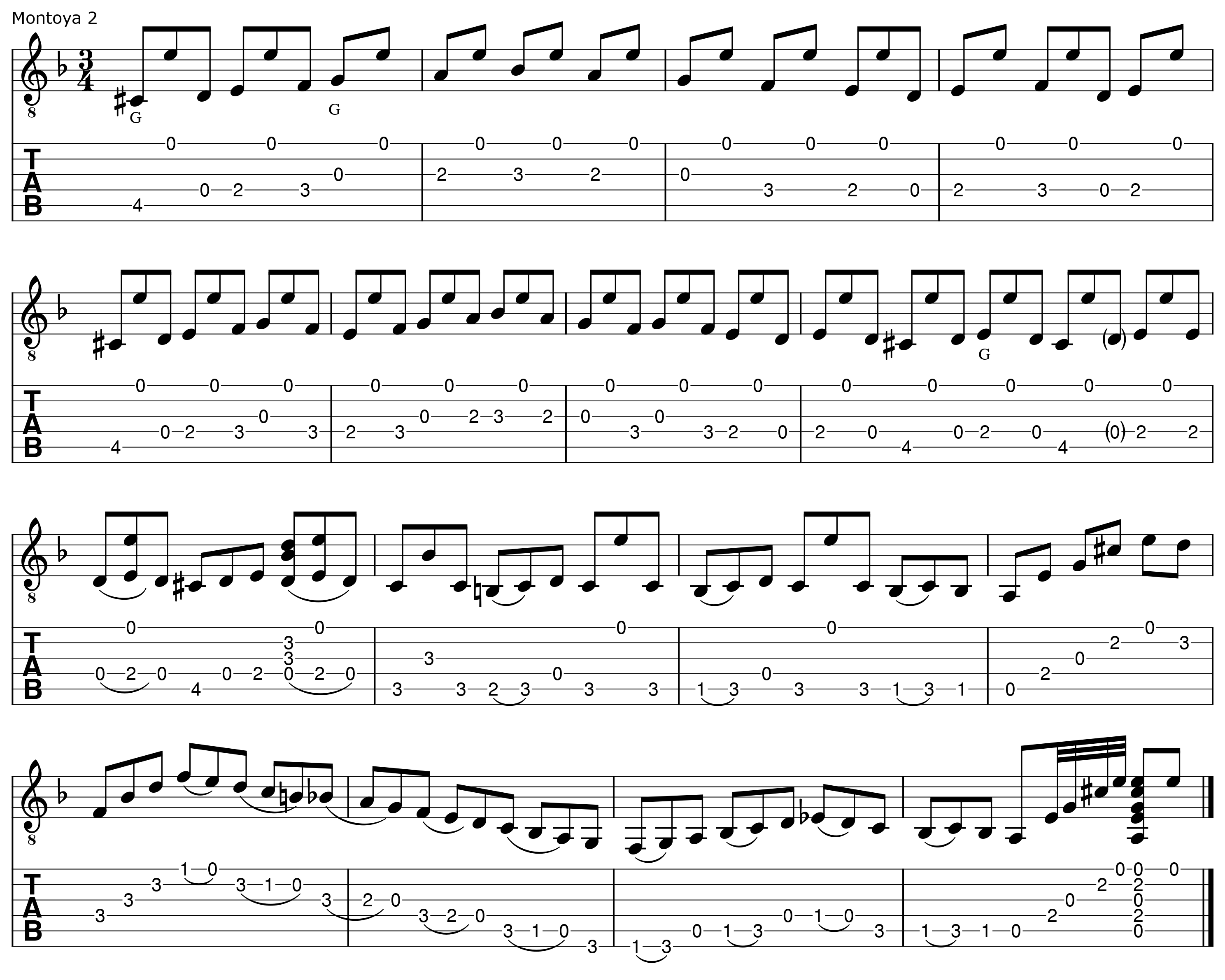
Ramón Montoya, example 3. From the same recording as the preceding example, this is a variation on the third falseta from example 2. He rushes the tempo considerably after the beginning.

Miguel Borrull hijo (1899–1976) recorded a simplified version of this falseta with el Cojo de Málaga in 1923. The double bar lines, placed between beats 12 and 1, show where one compás ends and the next one begins. The falseta concludes in typical Borrull fashion, with a supercharged picado run. Capo at the fifth fret.
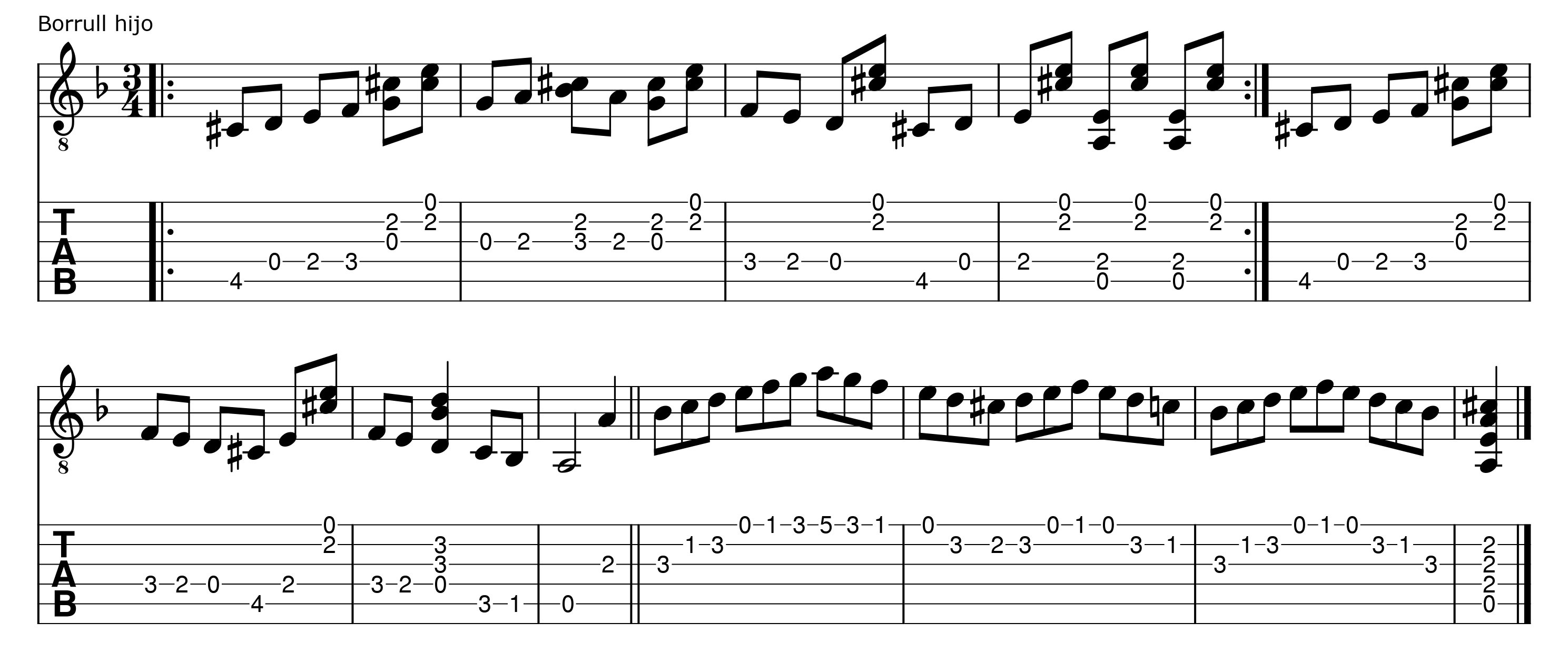
Antonio Moreno (1890–1937) was a talented professional guitarist who influenced Niño Ricardo. He recorded this falseta in 1933 with Pastora (he and Ricardo were the witnesses at the wedding of Pastora and Pepe Pinto that same year). Although this is part of a fandango ("Al doble de una campana") accompanied por arriba, it is very obviously a version of the falseta seen above. The index-finger aire of Antonio Moreno is heard clearly in the playing of Ricardo. Capo at the sixth fret.

Niño Ricardo (1904–1972) recorded the p-i-p mechanism on many occasions, especially por siguiriyas, although he used the technique far less frequently than other guitarists. In the example below, he echoed Ramón's falseta (example 2) in a soleá he recorded with el Gloria in 1929 (the first sung line is "Yo a la tierra solamente"). The idea is very similar to Ramón's, and the figure at the end of the first compás is identical. However, Ricardo's approach to rhythmic counterpoint involves much less brushing of adjacent strings, and the concluding falseta in the third compás is typical of his own integral approach to right- and left-hand inflection. Observe the thumb-and-index grip at beat 12 of the remate. To approach Ricardo's sound, "massage" the strings with your thumb and index, minimizing the distance between fingertips and strings. Capo at the fourth fret.
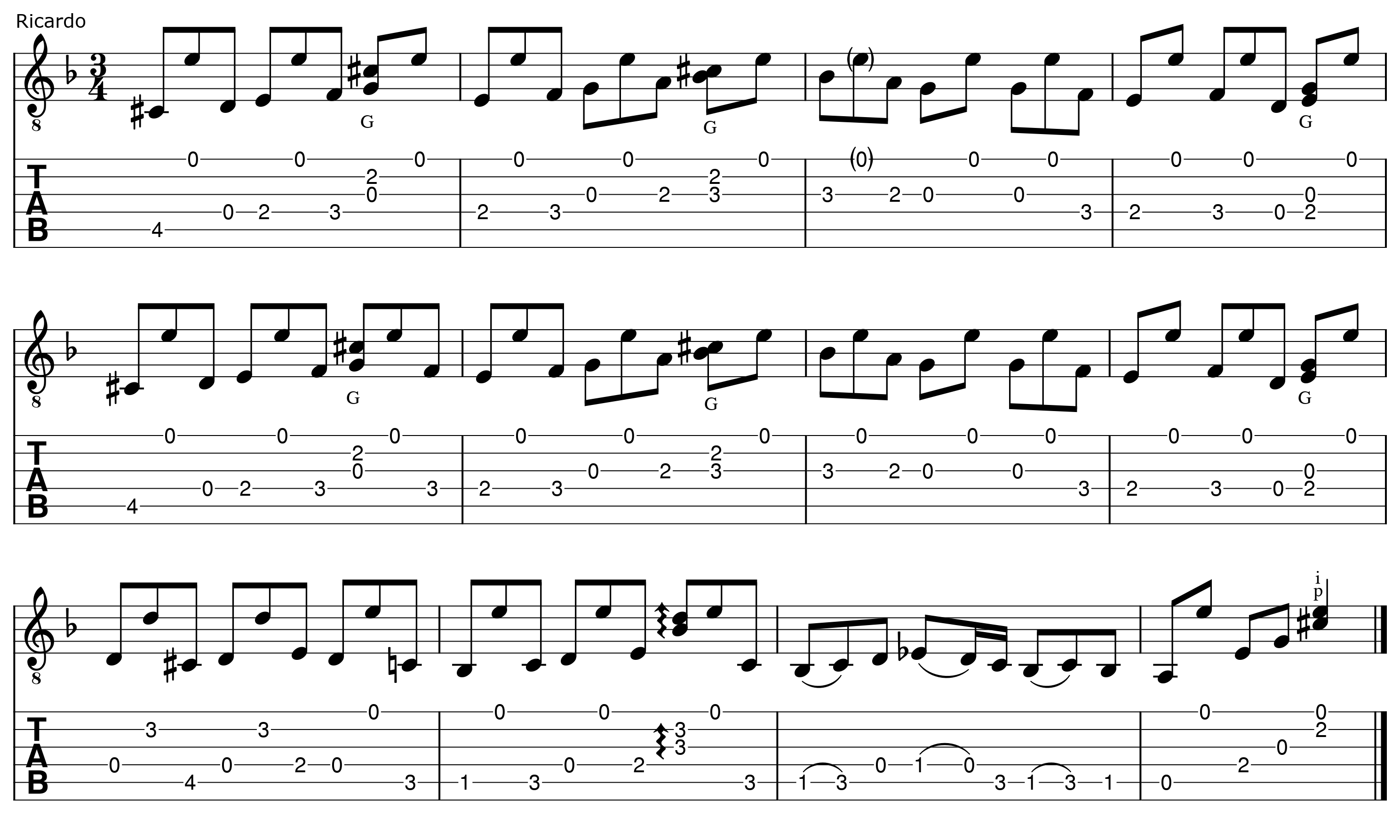
Melchor de Marchena (1907–1980). The p-i-p fingering reached its summit in the hands of the great Melchor de Marchena. Applying his absolute rhythmic mastery to this mechanism, he developed a surprisingly expressive and soulful means of expression. The following falseta, recorded with Pastora in 1950 in the soleá "Las fatigas me ahogaban," is an example of the dramatic starts and stops that characterize his playing. The notes in parentheses are not actually heard on the recording. Capo at the fourth fret.

Manuel Morao has contributed greatly to the development of this mechanism, creating a language for the guitar in which thumb, slur and index act as lung, tongue and mouth. In this way, he has enhanced and enriched the gypsy nature of siguiriyas, soleás, tientos, bulerías and other styles. Below, we can see just one example of this essential part of his playing, taken from the soleá "Qué cosas dice este loco" with Perla de Cádiz. Notice the use of the thumbed rest strokes in the ascending bass occurring on the last note of one triplet and the first note of the next. As in the preceding examples, the notes in parentheses would complete the pattern but don't appear on the recording. Notice how he shifts into overdrive at the end of the falseta with a burst of sixteenth notes, breaking away from the rhythmic patterns established by the fingerings in the first two measures. Capo at the sixth fret.

Paco de Antequera (1938–2000). His playing reflected the multifaceted approach of the guitarists of his generation, influenced by several well-developed schools. He cultivated an array of techniques and approaches including the p-i-p mechanism (maintained by Jerez-influenced guitarists). Notice how the technique is adapted to articulate sixteenth notes in the following falseta, in which the thumb plays all but the highest-pitched string. Taken from Terremoto's 1967 soleá "No sé lo que le ha dado." Capo at the third fret.
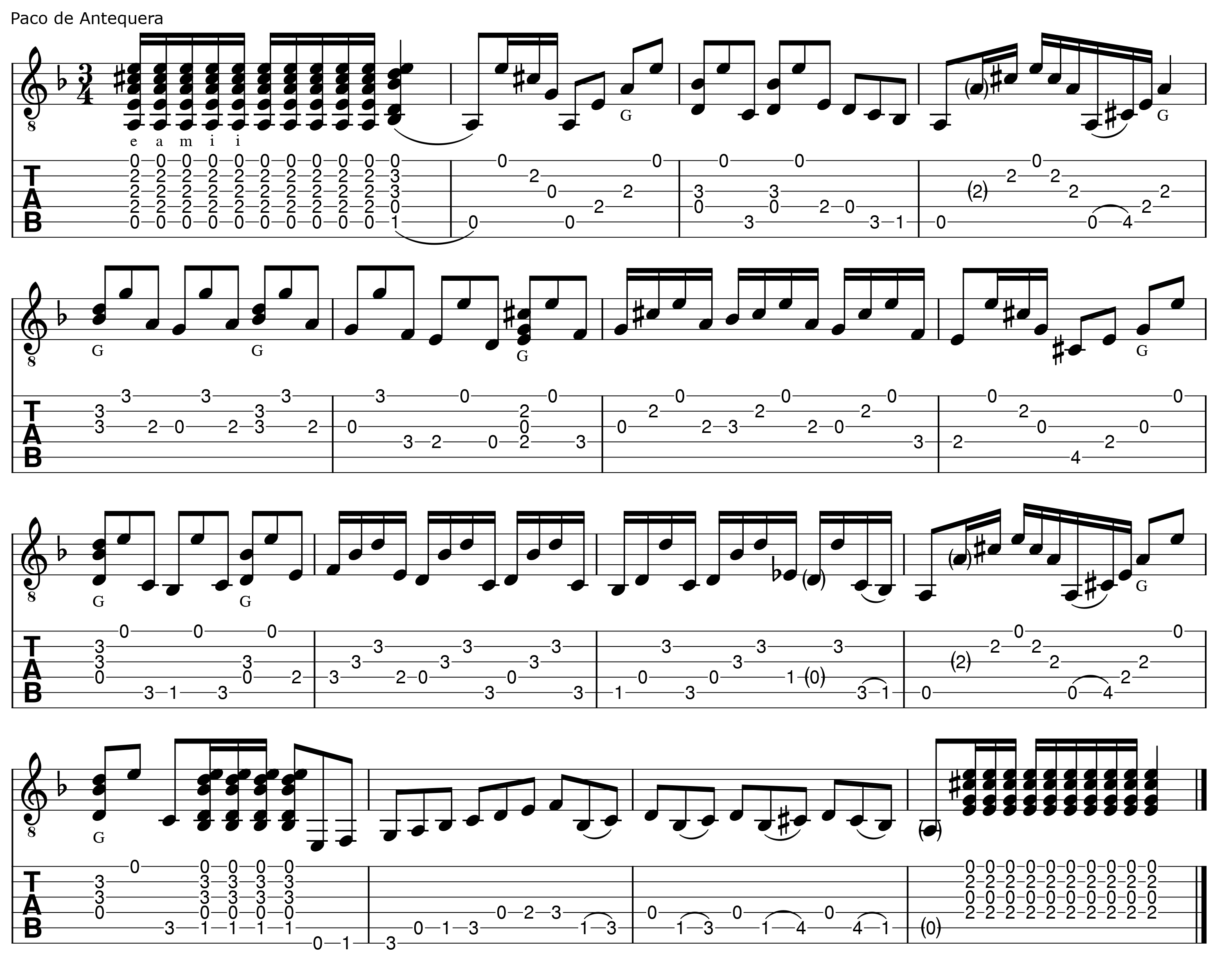
Manuel Parrilla (1945–2009) recorded this with tía Anica la Piriñaca in 1962 ("Qué malina era tu madre"). Manuel excelled in this technique and picado. Capo at the third fret.

Paco de Lucía (1947–2014) falseta 1, from "Solera," his brilliant 1973 distillation of the soleares style. Like Ricardo and Sabicas, he "remembered" Ramón's falseta (example 2). His index and thumb are precise and restrained here, much like Ricardo's, with very little of the brushing of adjacent strings heard from other players. Although Paco is better known for his alzapúas (see example 2), he also recorded several examples of the p-i-p mechanism. The oddly noted figure at beat eight is just a very fast left-hand flourish. Capo at the fourth fret.
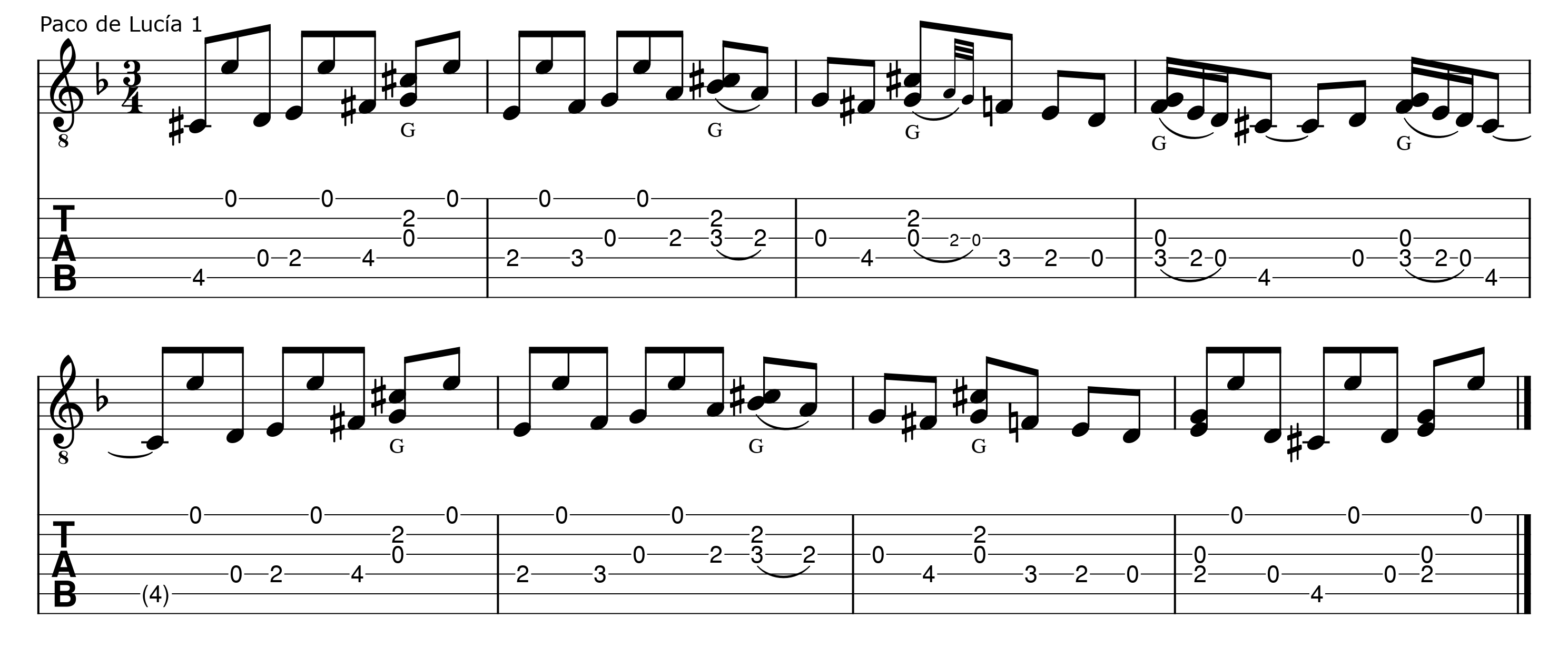
Juan Carmona (1933–2016) recorded this with José el de la Tomasa in 1995 ("Esta candelita lenta"). Juan was always famous for his extensive knowledge of singing styles, sensitive accompaniment and skilful playing, and his many p-i-p falsetas remain unparalleled in their clarity and precision. Although the following example may sound like alzapúa, several features clearly indicate that it is fingered p-p-i-p, such as the use of single strings (no brushing), the counterpoint on the second string (omits third string), and the lack of slurs in the ascending bass line (impossible with alzapúa). Check the slowed version of the audio to hear these details. The remate that concludes the falseta deserves special attention. This kind of mastery is the result of an entire life played by the guitar, and few artists with such highly developed technique have dedicated their lives to sensitive accompaniment. Capo at the sixth fret (the falseta is in the por arriba position of E-F).

The word alzapúa actually refers to a technique that sounds similar to the p-i-p mechanism but is played entirely with the thumb. Although it seems to be a recent variation (second half of 20th century) on the fingering used by Montoya, Melchor and Morao, little is known of its origin. In any case, it seems that Sabicas was the first to use this technique (with a slightly different fingering; see below). In recordings, alzapúas appear from the early 1960s onward in the playing of Diego de El Gastor and Paco de Lucía.
Sabicas (1912–1990) replaced the index in the p-i-p mechanism with a thumb upstroke, forming the pattern "brush down-brush up-bass." With the striking hand and forearm relatively still, the thumb plows through groups of strings, producing a characteristic sound. This differs from the p-i-p mechanism, as the downstroke and the upstroke brush across several strings instead of a single string, and the upstroke is also harsher in tone and brushes lower-pitched strings. The following falseta is from Sabicas' bulerías por soleá "Ecos Jerezanos" from the 1963 album "Flamenco Puro." Essentially, he is playing a variation on Ramón's idea, reworking the voicings to fit his striking-hand fingering. Although the notation does not include all the taps, it is meant to be an accurate representation of all the notes heard in the recording. Capo at the fifth fret.
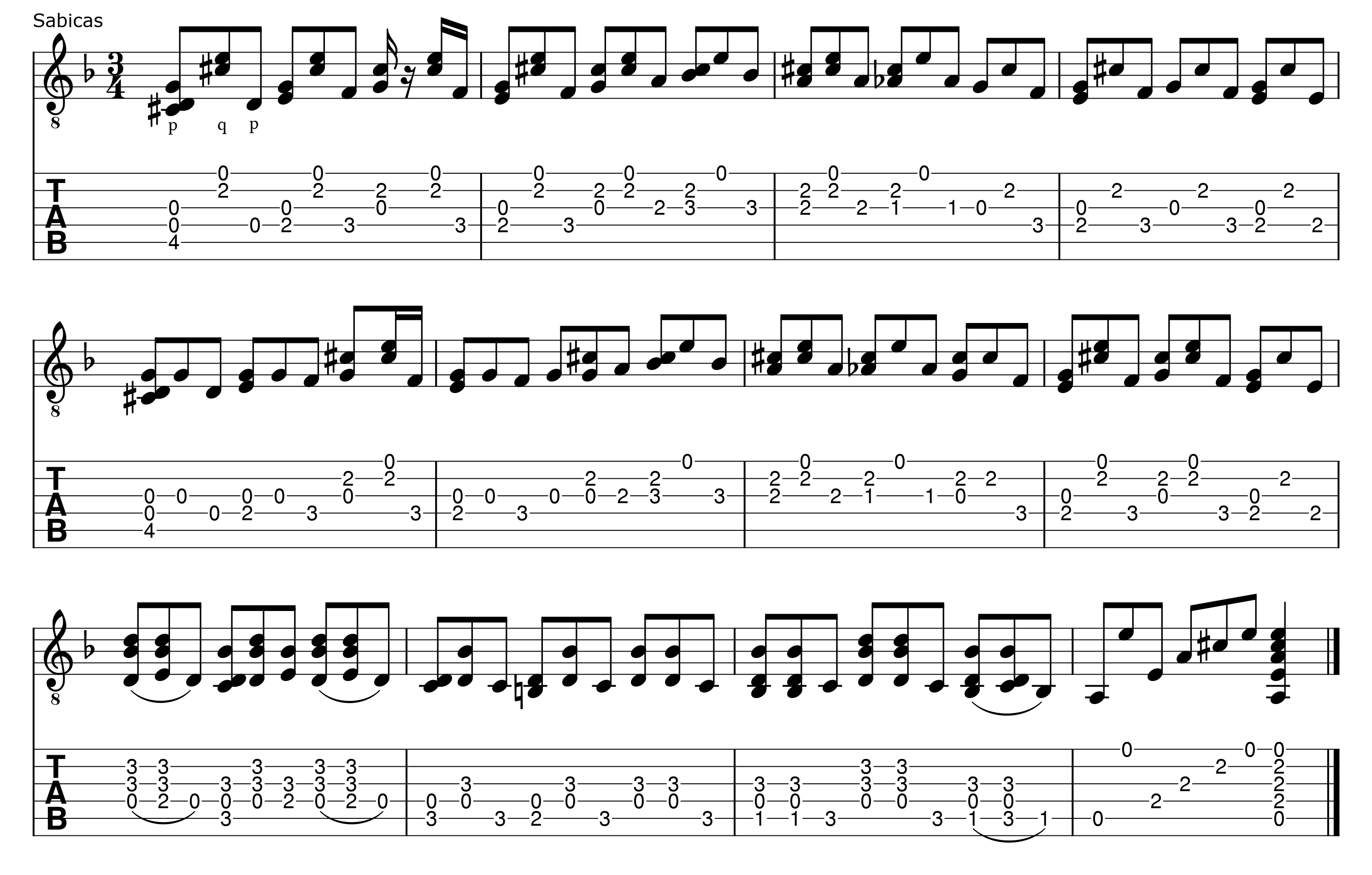
Diego de El Gastor (1908–1973) dug deeply into the alzapúa technique. By the early 1960s, the enigmatic gypsy was looping the three-part mechanism in eighth-notes por bulería, forming the pattern "bass-brush down-brush up." Although the fingering is similar to that used by Sabicas, the result is very different, especially when looping the ternary pattern in a binary rhythm (the eighth notes of this falseta). Although it is best kept to a minimum, a bit of forearm rotation adds rhythmic drive. According to nephew Paco de El Gastor, Diego played both types of alzapúa (rotating forearm and forearm kept still). The following falseta was taken from an untitled bulería recorded around 1967 with Fernanda de Utrera. Remember that this is a bulería, unlike the slower soleás (twice as slow) seen in the other examples, and it starts with a pickup measure on beat 12 (as indicated by the double bar line). Capo at the third fret.
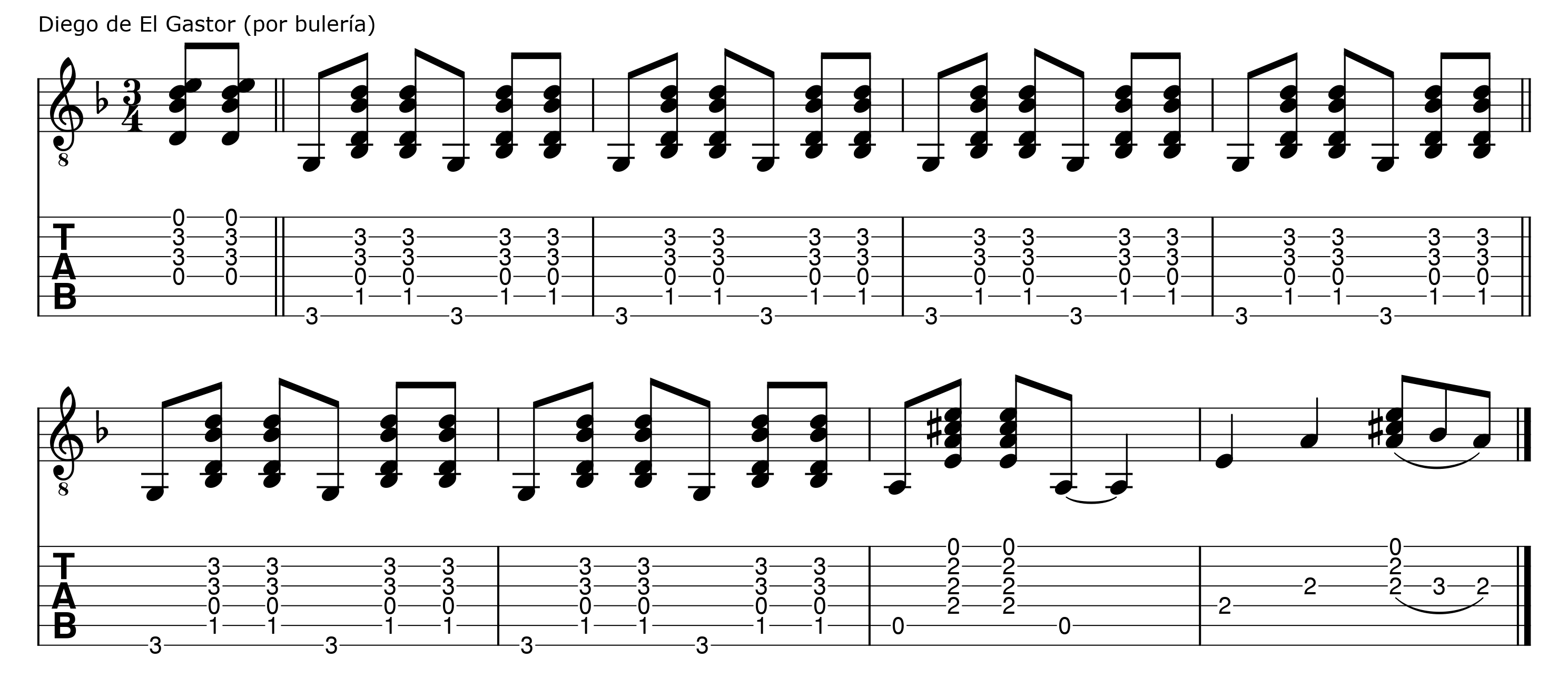
Paco de Lucía, falseta 2. Paco played excellent alzapúas throughout his career, and his development of this technique and others is well known. Like example 1, this falseta is from his soleá "Solera." The quintuplet figure at the third beat is unusual. It is interesting to note that, since his first recordings, he used both mechanisms and recorded both within the same track on several occasions ("La Tumbona" is a more recent example). Capo at the fourth fret.

The p-i-p fingering is still popular among Jerez-based guitarists and alzapúa has been developed greatly in recent decades, both mechanisms being effective means of expressing the driving nature of certain moments in flamenco. The preceding examples show three ways to make the ternary mechanism quaternary (binary in the case of Diego's bulerías): slurring on the same bass string (Morao), adding another bass string (Paco de Antequera), or "looping" the fingering in eccentric cycles (Diego).
The alzapúa falseta seen below is a very basic example of a modern approach, and it echoes the playing of Pepe Habichuela, Paco de Lucía and others. It starts with an eighth rest and the melody on the bass strings is played with rest strokes. Notice that, after the fourth-string rest stroke at the end of beat seven, the brushing in beat eight takes place on the second and third strings. The slurs require firm left-hand articulation and coordination of striking and fretting hands to create a smooth melodic line, particularly the "false" slur onto the fifth string, third fret.
